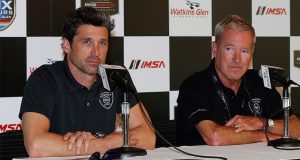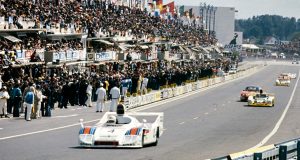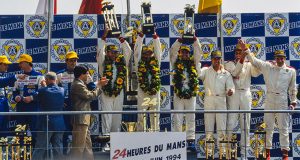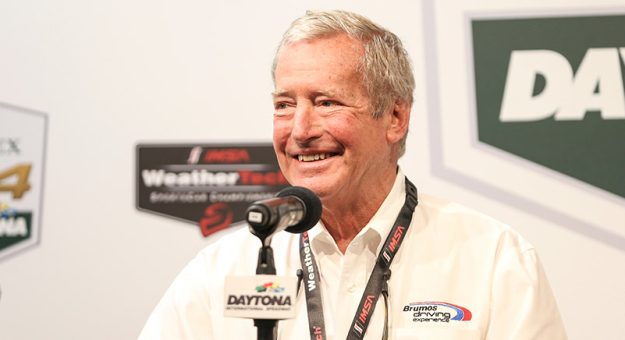The Racing Great Cites Wins at Le Mans and Watkins Glen, along with Pride Month as Cause for Celebration
By Holly Cain
DAYTONA BEACH, Fla. — For so many years in his celebrated sports car career, the month of June has been significant and particularly rewarding for Hurley Haywood.
From a career-launching race five decades ago at Watkins Glen International, where the IMSA WeatherTech SportsCar Championship races this week in the Sahlen’s Six Hours of The Glen – to Haywood’s acclaimed three victories in racing’s annual summertime endurance test, the 24 Hours of Le Mans. To Haywood’s deeply personal story in a month designated worldwide to celebrate LGBTQ+ pride.
Although Haywood says that most people in the sport knew – on some level – of his sexual orientation during much of his career, he only formally acknowledged being gay recently in the movie “Hurley,” executive produced by actor and sports car driver Patrick Dempsey. The film – an in-depth look at Haywood’s rise to superstardom and subsequent impacts on and off track – was released in 2018 and has proven to be nothing short of groundbreaking for the sport and for Haywood.

“Patrick Dempsey and (writer/producer) Derek Dodge, they just made a really powerful piece and I think the reaction from everybody has been very positive,’’ Haywood said.
Positivity is certainly something Haywood can claim in all aspects of his life.
He is unquestionably on sports car racing’s Mount Rushmore of competition. He bookended his time racing at Le Mans with a victory in his debut there in 1977 and in his final race there in 1994 – also winning in 1983.
Watkins Glen Served as Career Launching Pad
For all intents and purposes, his career launched at the historic Watkins Glen road course in 1969 – ironically with a hurriedly secured NASCAR license that ultimately helped him get clearance to compete in a six-hour event at the track that July. It was his first professional race.
“I think about that often because that really was sort of the steppingstone that put me in the light, so to speak. I hadn’t really been in a real professional race before that,’’ Haywood said. “Most of the races I’d been doing up to that point were regional races – I think I’d done only three or four. Then (co-driver) Peter (Gregg) said, ‘I think we should do Watkins Glen, the six-hour, the world championship race together.’ “
“When I arrived up in Watkins Glen, the sanctioning bodies were having an absolute fit, asking, ‘Who is this guy? We’ve never heard of this person,’’’ Haywood continued with a laugh. “And Peter stood up and said, ‘Trust me, he’ll be fine.’
“I was driving a factory-prepared (Porsche) 911 so it was a really good car, but I had never raced against that caliber of drivers, so I was a complete, absolute rookie going against the best drivers in the world, most of them driving prototypes. It was really an eye-opener, but it was intoxicating and I just loved it, and Peter and I won the GT portion of the race and I was on Cloud 9.”
It quickly became obvious that Haywood was on his way up and ready to take on bigger challenges, compete in bigger races. He returned to Watkins Glen often competing in IMSA-sanctioned races and winning a pair of Supercar races there in June 1991 and June 1992.

From Lost in Le Mans to Top of the Podium
For much of his career, Haywood was still splitting the month of June with competition in Watkins Glen and in Le Mans. Listening to Haywood recall his earliest days at Le Mans are special – his fond memories and stories so vivid to this day.
“My only connection to Le Mans before I actually went there in 1977 was the movie Steve McQueen made called ‘Le Mans,’” Haywood acknowledged. “I had watched that movie and fell in love with that whole concept.
“I sort of always had that in the back of my mind, but I really didn’t know the geography of where exactly Le Mans was and outside of seeing the movie, you had no idea what the actual city of Le Mans looked like.”
Haywood tells the story of renting a car at the Paris airport and driving to Le Mans, not understanding French and not sure exactly where to go to meet up with his race team – many of whom he’d never met before – when he arrived.
“I was just wandering around the streets hoping I would run into someone that had a Porsche jacket on,’’ Haywood said with a laugh. “Finally, that evening, like 10 o’clock at night, I was driving down this little alleyway and there was a guy that had a Porsche jacket on. I stopped and he looked in the window and he said, ‘Oh Mr. Haywood. We’ve been worried about you. Where have you been?’”
It turned out to be his team’s crew chief. And a couple days later, Haywood was raising a trophy and celebrating atop the famed Le Mans podium – the first of his three triumphs there.
Such was the life for Haywood during that time. In addition to his later wins at Watkins Glen and in the Twelve Hours of Sebring (1973 and 1981), Haywood would eventually establish the standard for victory at the famed Rolex 24 At Daytona – winning five times (1973, ’75, ’77, ’79 and ’91), a feat that has never been eclipsed.
He would return to Le Mans in 2019 – not as a racer but to be celebrated as the grand marshal – an honor he received again this past winter at the Rolex 24.

Sharing His Personal Story to Benefit Others
Yet for all the appreciation Haywood has deservedly received at a racetrack, he finds his comfort and greatest joy these days in being able to not just share but to cherish life with his decades-long partner, his husband Steve. In the open.
Haywood said he hopes his story will benefit others.
“I did it because youth today are faced with all kinds of problems,’’ Haywood said of agreeing to do the film with Dempsey. “When I was young, at that age, we didn’t have all the major events that are going on that kids have to get their arms around and deal with today.
“I just felt, if I could be helpful in that way, that’s why I agreed to do it. And the reception I’ve gotten from the film, from the general public – not only from those in racing, which I’d say has been very supportive – but the just the general public has been supportive.
“I’ve had fathers call me and say, ‘I saw that film with my son, and it really opened a window, and we were able to talk about it.’ That just really makes me feel good, that the endeavor was something that was worthwhile.”
And Haywood acknowledges, times are so different now than when he was a young man navigating his way.
“I think people have become more educated in what being ‘gay’ means,’’ Haywood said, “When I came out – which was basically in my early 20s – it was difficult for me to accept that personally and it was very difficult to discuss that with people that weren’t part of my family or part of some sort of support system.
“But as you fast forward to today, it’s pretty much mainstream. You’ve got a lot of Hollywood actors that have come out, you’ve got a lot of professional sports people that have come out – football players, professional basketball players, tennis players, everybody. I’m one of a handful of race car drivers – winning race car drivers – that have come out and I think that sort of sets a whole new platform of what you can do.”
Haywood recalled a story that has stuck with him for years. An aspiring young journalist – in his teens – did an interview with Haywood years ago and revealed that he was gay. The young man was struggling with how to reveal that information to his family and how to reconcile that in his everyday life.
“So, I gave him a couple pointers and got him steered in the right direction,’’ Haywood said. “And then I never heard from him again. About two years after that, I got a phone call which turned out to be his mother and she said, ‘I don’t know what you told my son, but you saved his life.’
“And that’s a heavy thing for a mother.’’
The experience has affected Haywood ever since and helped bring about perspective.
“People say, ‘How did you deal with that?’ and I say, ‘It was easy,’’’ Haywood explained of being so private during his career. “As long as I kept my foot down harder and longer than the guy next door, then nobody was going to complain.
“And that’s pretty much the way it was.
“It was something that was not discussed, really. Everybody kind of knew it in the racing industry but it was not discussed. As long as I was competitive and able to win races, nobody had a problem with that. Then when I retired, and the young man came up for that interview, I thought, ‘You know, maybe it’s time I give back something.’
“My whole life I’ve had the benefit of generosity and being able to drive the very best equipment for the very best teams and I said, ‘Maybe it’s time I give something back.”
His gift? A legacy of admiration both on and off the track that both offers example and perspective. And hope.
